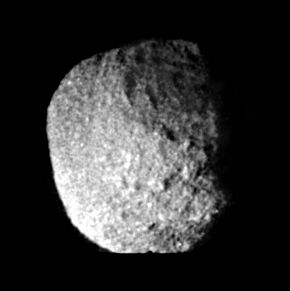Pharos (crater)
 A full-disc image of Proteus from the Voyager 2 spacecraft, with Pharos occupying much of the upper right | |
| Feature type | Impact crater Possible peak-ring impact basin |
|---|---|
| Location | Proteus |
| Coordinates | 10°0′S 10°0′W / 10.000°S 10.000°W[1] |
| Diameter | 255 ± 12 km (158.4 ± 7.5 mi)[2] |
| Depth | ~10 km (6.2 mi)[2] |
| Discoverer | Voyager 2 |
| Eponym | Lighthouse of Alexandria |
Pharos (/ˈfɛərɒs/ FAIR-oss) is the largest known impact crater on Neptune's moon Proteus. It is named after the island of Pharos, making it the only named surface feature on Proteus as of 2024. It measures 10–15 km deep and has a diameter of around 250 km (160 mi) in diameter, making it more than half the diameter of Proteus itself. The impact that created Pharos may have also created Hippocamp, due to how unusually close it is to Proteus.[3]
Observation and naming[edit]
Pharos was first discovered in the Voyager 2 spacecraft's flyby of Neptune and its system of moons in 1989, being one of the first identifiable features on Proteus.[4]: 1447 The impact basin was provisionally named in a 1992 paper by Steven K. Croft after the island of Pharos, whose only surviving remnant is the Ras el-Tin promontory.[5][6] The name was officially approved by the International Astronomical Union (IAU) in 1994.[7]
Geology[edit]

With a calculated diameter of 255 ± 12 km, Pharos is by far the largest known impact structure on Proteus. As Proteus's mean radius is ~210 ± 7 km, this makes Pharos over half the size of the satellite itself.[8] The impact basin is so large that it significantly affects Proteus's overall shape, appearing as if a facet has been carved from its limb.[5] Pharos is a relatively degraded crater, bound by an outer incomplete scarp interrupted by subsequent impacts. The floor of Pharos appears to be domed, but nevertheless lacks a clear central peak that characterizes central-peak impact craters. However, there may be a peak-ring structure with a diameter approximately half that of Pharos's outer rim, which may indicate that Pharos is a peak-ring impact basin. A series of depressions further surround Pharos, with a system of north-south oriented valleys bordering the southeast rim being the most prominent. Furthermore, a ridge appears to run parallel to the northeastern rim. The origins of these structures are unknown, though they may represent an even larger outer ring of Pharos, bringing Pharos's total diameter to between 500 and 550 km.[5][1]: 694
Despite the relatively poor image resolution of Voyager 2, several structures have been identified within Pharos. The most prominent are numerous smaller impact craters, the largest of which is roughly 100 km in diameter and occupies the southwestern floor of Pharos (located at roughly 40° S, 20° W). The northern floor contains a dome or hill-like structure roughly 20 km wide (located at roughly 5° S, 0° E); its origins are unknown, though a cryovolcanic origin is unlikely due to Proteus's small size and geological history. Much of Pharos's western floor is occupied by a broad, well-defined winding valley that resembles a graben. The valley is roughly 12 km across and at least 100 km long, cutting across the northern rim of the 100 km crater. As it appears to extend beyond the terminator in Voyager 2 imagery, it likely is longer. Imagery also indicates that the interior of Pharos may be darker than the surrounding terrain, though this remains uncertain.[5]
Given Pharos's large size relative to Proteus itself, the impact event that created Pharos was likely highly disruptive. Nevertheless, that Pharos's structure is relatively well-preserved indicates that Proteus was left relatively intact, rather than being brought "to the brink" of destruction. A system of possible tectonic faults and fractures both concentric and radially oriented to Pharos may be related to stresses from the Pharos impact event. Alternatively, the extensive fracturing on Proteus may be the result of partial relaxation of Pharos, or tidal stresses from the reorientation of Proteus due to the Pharos impact.[2][5] The Pharos impact would have also excavated large amounts of debris and ejecta, much of which would have escaped into direct Neptune orbit. Some of the escaped ejecta may have accreted into the neighboring moon Hippocamp, whose volume is only ~2% the estimated total volume of the Pharos basin. However, this conclusion is uncertain and Hippocamp may be unrelated to Pharos.[9]
See also[edit]
- Herschel – A similarly-sized impact crater on Saturn's moon Mimas
- Hippocamp – An inner moon of Neptune that may be a fragment of Proteus from the Pharos impact
References[edit]
- ^ a b Thomas, P. C.; Veverka, J.; Helfenstein, P. (1995). "NEPTUNE'S SMALL SATELLITES". Neptune and Triton: 685–699. Bibcode:1995netr.conf..685T.
- ^ a b c Croft, S. K. (16 March 1992). "Proteus: Geology, shape, and catastrophic destruction". Icarus. 99 (2): 402–408. Bibcode:1992Icar...99..402C. doi:10.1016/0019-1035(92)90156-2.
- ^ "Tiny Neptune Moon Spotted by Hubble May Have Broken from Larger Moon". HubbleSite. Space Telescope Science Institute. 20 February 2019. Retrieved 4 October 2021.
- ^ Smith, B. A.; Soderblom, L. A.; Banfield, D.; et al. (15 December 1989). "Voyager 2 at Neptune: Imaging Science Results". Science. 246 (4936): 1422–1449. Bibcode:1989Sci...246.1422S. doi:10.1126/science.246.4936.1422.
- ^ a b c d e Stooke, Philip J. (26 April 1994). "The Surfaces of Larissa and Proteus". Earth, Moon, and Planets. 65 (1): 31–54. Bibcode:1994EM&P...65...31S. doi:10.1007/BF00572198.
- ^ Haag, Michael (2008). Vintage Alexandria: Photographs of the City, 1860–1960. American University in Cairo Press. p. 113. ISBN 9789774161926.
- ^ "Planetary Names: Crater, craters: Pharos on Proteus". Gazetteer of Planetary Nomenclature. USGS Astrogeology. Retrieved 4 November 2021.
- ^ Karkoschka, Erich (2003). "Sizes, shapes, and albedos of the inner satellites of Neptune". Icarus. 162 (2): 400–407. Bibcode:2003Icar..162..400K. doi:10.1016/S0019-1035(03)00002-2.
- ^ Showalter, M. R.; de Pater, I.; Lissauer, J. J.; French, R. S. (19 December 2018). "The seventh inner moon of Neptune". Nature. 566 (7744): 350–353. Bibcode:2019Natur.566..350S. doi:10.1038/s41586-019-0909-9. S2CID 67772685.
